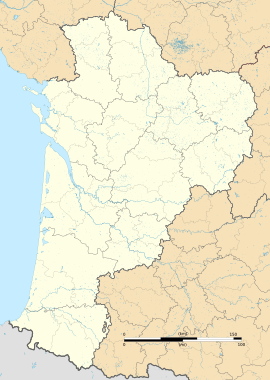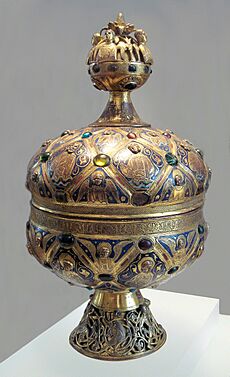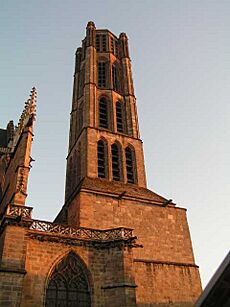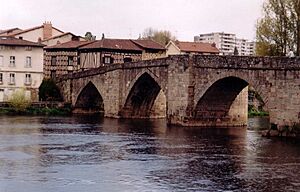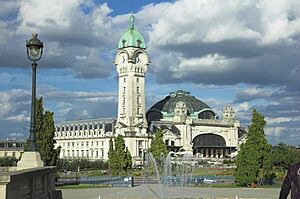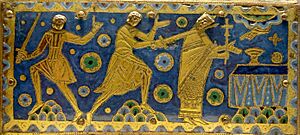Limoges facts for kids
Quick facts for kids
Limoges
Limòtges (Occitan)
|
||
|---|---|---|
|
Prefecture and commune
|
||
|
|
||
|
||
| Country | France | |
| Region | Nouvelle-Aquitaine | |
| Department | Haute-Vienne | |
| Arrondissement | Limoges | |
| Canton | Limoges-1, 2, 3, 4, 5, 6, 7, 8 and 9 | |
| Intercommunality | CU Limoges Métropole | |
| Area
1
|
77.45 km2 (29.90 sq mi) | |
| • Urban | 270.9 km2 (104.6 sq mi) | |
| • Metro | 3,407 km2 (1,315 sq mi) | |
| Population
(2021)
|
129,760 | |
| • Density | 1,675.40/km2 (4,339.3/sq mi) | |
| • Urban
(2018)
|
186,799 | |
| • Urban density | 689.55/km2 (1,785.9/sq mi) | |
| • Metro
(2018)
|
323,789 | |
| • Metro density | 95.036/km2 (246.14/sq mi) | |
| Time zone | UTC+01:00 (CET) | |
| • Summer (DST) | UTC+02:00 (CEST) | |
| INSEE/Postal code |
87085 /87000
|
|
| Elevation | 209–431 m (686–1,414 ft) (avg. 294 m or 965 ft) |
|
| Website | www.ville-limoges.fr | |
| 1 French Land Register data, which excludes lakes, ponds, glaciers > 1 km2 (0.386 sq mi or 247 acres) and river estuaries. | ||
Limoges is a lively city in west-central France. It's the main city, or prefecture, of the Haute-Vienne area. Limoges used to be the capital of the old Limousin region. The city sits on the first hills of the Massif Central mountains. The Vienne River flows through Limoges, and it was once an important place to cross the river.
Limoges is the second biggest city in the New Aquitaine region, after Bordeaux. It's a university town and a busy center for services. About 323,789 people lived in its wider urban area in 2018. People from Limoges are called Limougeauds.
The city was founded around 10 BC by the Romans and was called Augustoritum. It grew into a major Gallo-Roman city. In the Middle Ages, Limoges became famous for its beautiful enamels, which were sold all over the Christian world. Later, in 1765, a special clay called kaolin was found nearby. This led to the growth of the famous Limoges porcelain industry. Sometimes, people call Limoges "the red city" because of its history of workers' movements.
Today, Limoges is also known for its successful basketball team, Limoges CSP. They have won many French championships and even a European championship in 1993. The city is recognized as a "City of Art and History" because it protects its old buildings and culture. Limoges is also important for making luxury goods, like porcelain, enamel art, and stained glass. In 2017, UNESCO recognized Limoges for its amazing crafts and popular arts.
Contents
Discovering Limoges
A Look at Limoges' Past
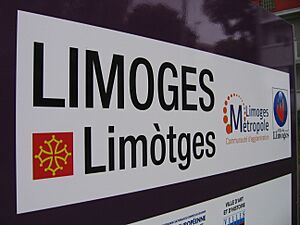
Ancient Times
Before Limoges was a city, small groups of people lived in the area. The Gaulish people called the Lemovices lived here. The Romans founded the city around 10 BC and named it Augustoritum. This name means "ford of Augustus," showing it was an important river crossing.
The Roman city was very grand. It had a large amphitheatre for shows, a theater, a forum (a public square), baths, and temples. The city was built in a typical Roman square shape with two main streets. It was so important that it even had its own Senate and money! Later, the city was renamed after the Lemovices tribe, which eventually became "Limoges."
The Middle Ages
Saint Martial brought Christianity to Limoges around 250 AD. But by the late 200s, people started leaving the city because of attacks from Germanic tribes. They moved to a safer, more easily defended spot. Later, the Abbey of Saint-Martial was built in the 9th century. Another town grew around the saint's tomb.
From the 11th century, Limoges became a center for art. This was thanks to the Abbey of St. Martial and its huge library. It was home to a famous school of medieval music. A well-known poet and musician named Bertran de Born was part of this school.
In the 13th century, Limoges was at its best. It had two main parts, both with strong walls.
- The main town was home to clerks and workers. It had a bridge over the Vienne River and a busy port.
- The castle area included the abbey and was controlled by the abbot.
In 1370, during a war, Edward, the Black Prince took over Limoges. Sadly, many people were killed during this time.
Modern Era

The famous porcelain industry began to grow in Limoges. This happened after kaolinite clay was found nearby in 1768. Many people started working in porcelain factories or in related jobs, like cutting wood for the kilns. Limoges became known worldwide for its beautiful porcelain.
The Limousin region has a long history of raising animals, especially Limousine cows. Because of this, the leather industry also grew in Limoges. Factories still make luxury leather shoes, gloves, and bags today.
In 1792, the town and the castle areas joined together to form the single city of Limoges. During the French Revolution, some religious buildings were destroyed. In the 19th century, Limoges saw a lot of new building. Many parts of the city center were rebuilt. Workers' rights became a big topic, and the first French workers' union, the General Confederation of Labour (CGT), was formed in Limoges in 1895.
In 1905, there were strikes in shoe and porcelain factories. The army had to step in, and sadly, there were some casualties. During World War II, many Jewish people from Alsace found safety in Limoges.
Limoges' Climate
Limoges has an oceanic climate, which means it has mild winters and warm summers. It rains quite a bit, especially from October to February. In winter, the city usually has about 41 days of frost and 18 days of snow. In summer, rain often comes from strong thunderstorms.
| Climate data for Limoges (LIG), elevation: 402 m (1,319 ft), 1991–2020 normals, extremes 1973–present | |||||||||||||
|---|---|---|---|---|---|---|---|---|---|---|---|---|---|
| Month | Jan | Feb | Mar | Apr | May | Jun | Jul | Aug | Sep | Oct | Nov | Dec | Year |
| Record high °C (°F) | 17.2 (63.0) |
23.1 (73.6) |
24.7 (76.5) |
27.8 (82.0) |
29.8 (85.6) |
36.3 (97.3) |
38.2 (100.8) |
37.2 (99.0) |
34.5 (94.1) |
30.0 (86.0) |
22.9 (73.2) |
18.3 (64.9) |
38.2 (100.8) |
| Mean daily maximum °C (°F) | 7.2 (45.0) |
8.4 (47.1) |
12.1 (53.8) |
14.8 (58.6) |
18.5 (65.3) |
22.0 (71.6) |
24.2 (75.6) |
24.4 (75.9) |
20.6 (69.1) |
16.2 (61.2) |
10.7 (51.3) |
7.9 (46.2) |
15.6 (60.1) |
| Daily mean °C (°F) | 4.6 (40.3) |
5.1 (41.2) |
8.2 (46.8) |
10.6 (51.1) |
14.1 (57.4) |
17.5 (63.5) |
19.5 (67.1) |
19.6 (67.3) |
16.2 (61.2) |
12.7 (54.9) |
7.8 (46.0) |
5.3 (41.5) |
11.8 (53.2) |
| Mean daily minimum °C (°F) | 1.9 (35.4) |
1.7 (35.1) |
4.3 (39.7) |
6.4 (43.5) |
9.8 (49.6) |
13.0 (55.4) |
14.7 (58.5) |
14.8 (58.6) |
11.9 (53.4) |
9.2 (48.6) |
5.0 (41.0) |
2.6 (36.7) |
7.9 (46.2) |
| Record low °C (°F) | −19.2 (−2.6) |
−15.0 (5.0) |
−9.6 (14.7) |
−4.7 (23.5) |
−0.6 (30.9) |
4.0 (39.2) |
7.2 (45.0) |
5.4 (41.7) |
2.6 (36.7) |
−2.6 (27.3) |
−7.2 (19.0) |
−10.6 (12.9) |
−19.2 (−2.6) |
| Average precipitation mm (inches) | 90.6 (3.57) |
75.0 (2.95) |
77.8 (3.06) |
87.7 (3.45) |
92.6 (3.65) |
80.0 (3.15) |
62.5 (2.46) |
71.6 (2.82) |
74.9 (2.95) |
94.2 (3.71) |
106.1 (4.18) |
105.0 (4.13) |
1,018 (40.08) |
| Average precipitation days (≥ 1.0 mm) | 13.2 | 11.2 | 11.2 | 12.0 | 11.2 | 9.5 | 8.3 | 8.1 | 9.7 | 12.1 | 13.9 | 13.3 | 133.7 |
| Average snowy days | 4.6 | 3.8 | 2.7 | 2.0 | 0.2 | 0.0 | 0.0 | 0.0 | 0.0 | 0.1 | 1.7 | 3.0 | 18.1 |
| Average relative humidity (%) | 85 | 80 | 76 | 71 | 75 | 73 | 71 | 72 | 75 | 80 | 82 | 84 | 77 |
| Mean monthly sunshine hours | 79.6 | 104.1 | 157.6 | 173.0 | 205.6 | 224.4 | 243.5 | 236.8 | 198.0 | 135.0 | 85.6 | 78.9 | 1,922 |
| Source 1: Meteo France (snow days 1981-2010) | |||||||||||||
| Source 2: Infoclimat.fr (relative humidity 1961–1990) | |||||||||||||
How Many People Live in Limoges?
In 2018, about 131,479 people lived in Limoges itself. The larger urban area had about 323,789 residents. People from Limoges are called limougeauds. The city has grown a lot over the years. In 1962, the nearby town of Beaune-les-Mines joined Limoges.
| Historical population | |||||||||||||||||||||||||||||||||||||||||||||||||||||||||||||||||||||||||||||||||||||||||||||||||||||||||||||||||||
|---|---|---|---|---|---|---|---|---|---|---|---|---|---|---|---|---|---|---|---|---|---|---|---|---|---|---|---|---|---|---|---|---|---|---|---|---|---|---|---|---|---|---|---|---|---|---|---|---|---|---|---|---|---|---|---|---|---|---|---|---|---|---|---|---|---|---|---|---|---|---|---|---|---|---|---|---|---|---|---|---|---|---|---|---|---|---|---|---|---|---|---|---|---|---|---|---|---|---|---|---|---|---|---|---|---|---|---|---|---|---|---|---|---|---|---|
|
|
||||||||||||||||||||||||||||||||||||||||||||||||||||||||||||||||||||||||||||||||||||||||||||||||||||||||||||||||||
| Source: EHESS and INSEE (1968-2017) | |||||||||||||||||||||||||||||||||||||||||||||||||||||||||||||||||||||||||||||||||||||||||||||||||||||||||||||||||||
What to See in Limoges
Limoges has many interesting places to visit:
- The Crypt of Saint Martial is from the 10th century. It holds the tomb of the bishop who brought Christianity to the city. It was found in the 1960s.
- You can still see parts of the Gallo-Roman amphitheater. It was one of the biggest in ancient Gaul!
- The beautiful Limoges Cathedral (Cathédrale Saint-Étienne de Limoges) was started in 1273. It took a very long time to finish, finally completed in 1888. Look for its fancy screen from 1534 and its unique bell tower.
- The Chapel of St. Aurelianus (14th–17th centuries) has old statues and amazing Baroque art. It also holds the relics of St. Aurelian, the second bishop of Limoges.
- The Church of St. Pierre du Queyroix was started in the 12th century.
- The Church of St. Michel des Lions began in 1364. It has relics of St. Martial and beautiful stained-glass windows. Its tall, 65-meter tower with a bronze ball on top is very striking.
- Don't miss the old bridges: the Saint Martial Bridge (from Roman times) and the St-Etienne Bridge (13th century).
- The Limoges Fine Arts Museum is in the old bishops' palace from the 18th century.
- The stunning railway station, Gare de Limoges Bénédictins, opened in 1929.
- The Château de La Borie (17th century) is a castle about 4 km from the city. It's now a cultural center.
- You can also see the remains of the 12th-century Castle of Chalucet, about 10 km south of Limoges.
- The city's botanical gardens, including the Jardin botanique de l'Evêché, are next to the cathedral.
- The University of Limoges was founded in 1968.
Art and Creativity in Limoges
You might know Limoges from music! "Le marché de Limoges" (Limoges market) is a part of the famous music piece Pictures at an Exhibition by Modest Mussorgsky.
In 1768, a special white clay called kaolin was found near Limoges. This clay is perfect for making porcelain. Because of this discovery, a new ceramics industry started. Soon, Limoges porcelain became very famous. Today, more than half of all porcelain made in France comes from Limoges! It's a general name for porcelain made in the area, not just one factory.
Limoges is also home to the national ceramics school, École d'ingénieurs ENSIL-ENSCI, which started in 1893.
Sports in Limoges
Limoges is a big city for basketball in France! The Palais des Sports de Beaublanc is a stadium that has hosted international basketball games. It's also the home court for the professional team CSP Limoges. This team has won the French championship 11 times! They even won the European championship in 1993, becoming the first French club to do so in a team sport.
Limoges also has a handball team called Limoges Hand 87. They play in a high division of French handball.
Before 2020, Limoges FC was the city's main association football (soccer) team. They played at Stade St. Lazare.
USA Limoges is an amateur rugby union club. They play in a top amateur league in France.
Getting Around Limoges
The main train station in Limoges is the Limoges-Bénédictins station. From here, you can travel directly to Paris and Toulouse, as well as other regional places. Limoges was one of the last major French cities to get connected to the national motorway system. Now, the A20 motorway links Limoges to cities like Paris in the north and Toulouse in the south. The closest airport is Limoges – Bellegarde Airport.
For getting around the city, Limoges has a public transport system called STCL. This includes a unique trolleybus system, which is one of only four in France!
Famous People from Limoges
Many notable people have come from Limoges:
- Bernard Gui (1261–1331), a famous Inquisitor.
- Jean Daurat (1508–1588), a poet and scholar.
- Jean-Baptiste Jourdan (1762–1833), a marshal of France.
- Thomas Robert Bugeaud de la Piconnerie (1784–1849), another marshal of France.
- Jean Cruveilhier (1791–1874), an anatomist and pathologist.
- Marie François Sadi Carnot (1837–1894), who became the President of France.
- Pierre-Auguste Renoir (1841–1919), a world-famous painter.
- André Antoine (1858–1943), a pioneer in theater and film.
- Maryse Bastié (1898–1952), a brave aviator.
- Fred Sirieix (born 1972), a well-known maître d'hôtel.
Limoges' Sister Cities
Limoges has special connections with other cities around the world, called "twin towns" or "sister cities." These connections help people from different countries learn about each other's cultures. Limoges is twinned with:
 Charlotte, United States
Charlotte, United States Fürth, Germany
Fürth, Germany Grodno, Belarus
Grodno, Belarus Plzeň, Czech Republic
Plzeň, Czech Republic Seto, Japan
Seto, Japan Icheon, South Korea
Icheon, South Korea
Images for kids
-
Limoges enamel ciborium with champlevé enamel, and center rim in pseudo-Kufic script, c. 1200
-
The murder of Thomas Becket, Limoges enamel, 12th century, Louvre Museum
See also
 In Spanish: Limoges para niños
In Spanish: Limoges para niños










